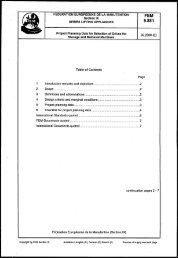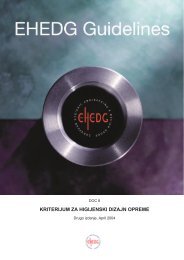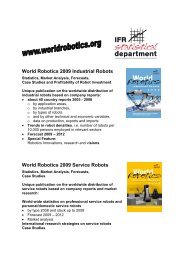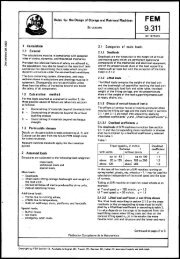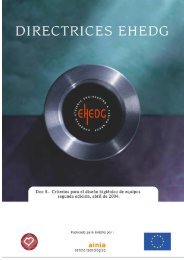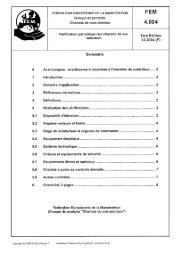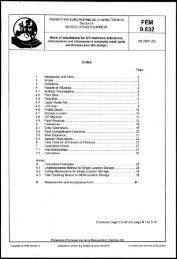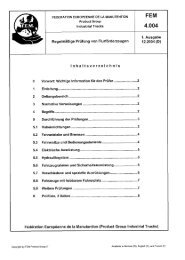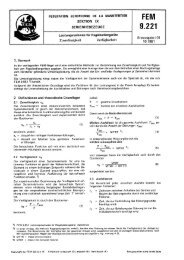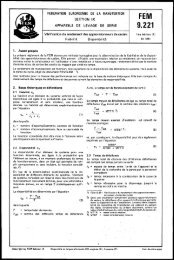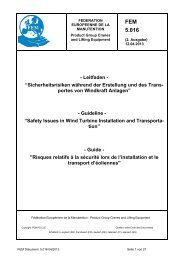to get a complimentary download version - (FKM), Verträge und ...
to get a complimentary download version - (FKM), Verträge und ...
to get a complimentary download version - (FKM), Verträge und ...
You also want an ePaper? Increase the reach of your titles
YUMPU automatically turns print PDFs into web optimized ePapers that Google loves.
Performance testing of air filters for hygienic environments: Standards and guidelines in the 21st century 51Similar <strong>to</strong> EN 1822, the new international standard ISO 29463denes the scan test method as the reference method, wherethe local and the integral particle collection efciencies aremeasured for the most penetrating particle size (MPPS).Table 1 denes the ISO lter classes and the related collectionefciencies and penetrations, respectively. In <strong>to</strong>tal, the testand classication procedure consists of four individual steps(1) Determination of the MPPS by measuring the fractionalcollection efciency curve as a function of the particle size onat sheet media samples (see part 3 of the standard); (2) leakprooftesting of the lter element (see part 4 of the standard);(3) determination of the integral efciency of the lter element(see part 5 of the standard); and (4) classication according <strong>to</strong>Table 1 (see part 1 of the standard). In part 3 of the standard,the required statistical methods are described.General ventilation air ltersCoarse and ne dust lters ensure sufcient indoor airquality in less critical production areas and in generalbuilding and ofce ventilation. In high care production areas,cleanrooms and associated controlled environments, theselters are used as pre-lters <strong>to</strong> the EPA, HEPA and ULPAlters. Coarse and ne dust lters are tested and classiedin Europe according <strong>to</strong> EN 779. In contrast <strong>to</strong> the testingof HEPA and ULPA lters, the procedure in EN 779 is adestructive test method, where the tested element is loadedwith a synthetic test dust known as ASHRAE dust. The lterclasses are determined from the average arrestance andthe average efciency as averaged over the dust loading.This standard has recently been revised and published asEN 7792012. The main modication in this revision is theintroduction of requirements for the minimum efciencies <strong>to</strong>the lter classes F7 <strong>to</strong> F9, which gives higher operationalsafety <strong>to</strong> the end users with regard <strong>to</strong> the particle collectionefciency of lter elements (Table 2).Table 2. Class denitions <strong>to</strong> EN 7792012.GroupCoarse lterFine lterGMClassFinal testpressuredropAveragearrestance A m<strong>to</strong> ASHRAEdust in %G1G2250 Pa50 A m< 6565 A m< 80G3 80 A m< 90G490 A mM5Averageefciency E m<strong>to</strong> 0.4 μm in %Minimumefciency <strong>to</strong>0.4 μm in %— —40 E m< 60M6 60 E m< 80F F7 450 Pa — 80 E m< 90 35F8 90 E m< 95 55F9 95 E m 70To ensure a high condence level of end users with regard<strong>to</strong> the quality and design specications of ne air lters,the European Committee of Air Handling & RefrigerationEquipment Manufacturers (EUROVENT) introduced some yearsago a certication program, wherein the main performancecharacteristics of the products offered by the participants areveried by regular and independent checks (www.euroventcertication.com).On an annual base, the initial pressure—drop, the initial and minimum particle collection efciency, thelter class, and the energy efciency class of four randomlychosen ne lters from the participants product range areveried by independent labora<strong>to</strong>ries.Figure 1. EUROVENT certication mark.Energy efcient operation of air ltersIn the context of increasing energy prices and the imperativeof reducing CO 2emissions, the energy consumption causedby air handling units has become the focus of attention. Inan average industrial plant approximately 10-20% of the <strong>to</strong>talenergy is consumed by fans in heating, ventilation and airconditioning (HVAC) systems. In high care production areasand in cleanrooms and associated controlled environments,this percentage is even higher. Approximately one-third isrelated <strong>to</strong> the ow resistance (pressure loss) of air lters,depending on the size and the design of the HVAC units.Besides investments in energy-efcient fans and variablespeed drives, for example, the optimisation of the lterefciencies used and the use of high quality, energy efcientair lters is a comparably easy possibility <strong>to</strong> achieve signicantenergy savings. Hence, a reduction of the pressure loss of airlter systems can make a signicant contribution <strong>to</strong> energysavings and reduction of carbon dioxide emissions whenused in conjunction with variable speed drives. At the sametime, the air quality tar<strong>get</strong>s have <strong>to</strong> be considered, whichmeans that ultimately the individual optimum of sufcientlter efciency with lowest possible energy consumptionmust be fo<strong>und</strong>.To guide the end user <strong>to</strong> the most energy efcient lterselection, EUROVENT published a new document, Eurovent4/11, which denes an energy efciency classicationsystem for air lters.Under the assumption that the volume ow rate suppliedby the fan is constant, and hence, does not depend on thelters‘ pressure drop, the energy consumption of air lterscan be calculated by Equation 1 (Goodfellow, 2001).q V ptW (1)The abovementioned assumption is valid if the fan iscontrolled by a frequency inverter <strong>to</strong> operate at constantvolume ow rate q V(in m³/s). In Eq. (1) W (in kWh) is theenergy consumed in the time t (in h). Since the pressure lossof an air lter increases with the dust collected during the timeof operation, in Eq. (1) the pressure loss p (in Pa) has <strong>to</strong> beintroduced as integral average value over the time interval t.The overall electromechanical fan efciency depends onthe design and the operating conditions of the fan. Modernfans can have an efciency of 70%; while for older modelsor when utilised in disadvantageous operating conditions,realised efciencies might be just 25% or even lower.



